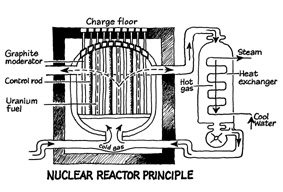The nuclear power industry and reactor technology have constantly been developing for more than five decades now. Nuclear reactors can be classified based on their nuclear reaction, the moderator material used, generation of the reactor, fuel phase, fuel type, coolant used, etc. The fusion nuclear reactors are mainly dealt with because the fusion reactors are still in the developing stages, and the fission reactors are already being used for the past six decades.

Based on nuclear reaction
This type refers to the thermal (slow) reactors and the fast reactors based on neutrons’ speed. Thermal reactors are the most affordable and ordinary as they use natural and raw uranium. The neutrons are decelerated from their natural rate when emitted from the broken atomic nuclei and moderated material in the process. Fast reactors are costly that require more enriched fuel.
Based on moderator material
Thermal reactors (because of the moderating material), Graphite, Normal water, and Heavy water are also used as moderators. The Graphite and the Heavy water reactors’ moderating materials thermalize the neutrons and keep the natural uranium intact without any enrichment.
Based on generation
Generation I reactors were the prototype reactors, Generation II used standard designs till the 50s, Generation III was more modern, lightweight, more efficient and was used till late 90s, the latest, i.e., Generation IV reactors targeting economic and minimal waste, are still in the research and development stage which may officially work until late 2020s.
Based on fuel phase and fuel type
It is a Solid, Liquid, or Gas reactor where Solid is most typical. The fuel type reactors also come with a fuel phase- uranium or thorium, available in abundant quantities on the land.
Based on use
They are power plants, breeder reactors (nuclear fuel production), research reactors, etc.
Though the heat from nuclear reactors is used to generate approximately about 16% of the world’s electricity and have been used on satellites and act as power sources for aircraft, rockets, and locomotives, what concerns the eco-biologists is how much this heat emitted is safe for the global citizens?
Realistically speaking, the radioactive waste emitted from these reactors carries risks for centuries or longer. Using this material cannot be completely done safely and securely, and the powerful potential for weaponry and environmental damage overshadows the nuclear energy benefits. It is more of a debate as there are varied opinions on this issue with global warming effects already becoming apparent. The alternative solutions to deal with it by other energy sources and their consequences are also heating the whole thing, in the current scenario. The most significant advantage with nuclear energy, of course, is the production of a vast amount of electricity with only a small amount of material, but the benefits look more restricted. A simple malfunction at the reactor or during the fission process can have devastating consequences, for instance, Three Mile Island in the US and Chernobyl in Russia in the past. Even a small amount of nuclear waste can have a huge impact on the surroundings for thousands of years or more because they are highly radioactive at first. The radioactivity slowly decreases with time, taking even 500 years or more. Entirely securing these reactors is impossible, and nuclear power generation may not be friendly to the environment with the risks it possesses, unlike other renewable energy resources.






I am very worry the security of Nuclear power station.